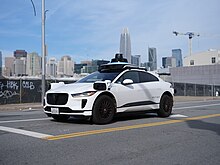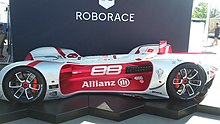| Part of a series on |
| Self-driving cars & self-driving vehicles |
|---|
 |
| Enablers |
| Topics |
| Related topics |
A self-driving car, also known as a autonomous car (AC), driverless car, robotaxi, robotic car or robo-car,[1][2][3] is a car that is capable of operating with reduced or no human input.[4][5] Self-driving cars are responsible for all driving activities, such as perceiving the environment, monitoring important systems, and controlling the vehicle, which includes navigating from origin to destination.[6]
As of late 2024[update], no system has achieved full autonomy (SAE Level 5). In December 2020, Waymo was the first to offer rides in self-driving taxis to the public in limited geographic areas (SAE Level 4),[7] and as of April 2024[update] offers services in Arizona (Phoenix) and California (San Francisco and Los Angeles). In June 2024, after a Waymo self-driving taxi crashed into a utility pole in Phoenix, Arizona, all 672 of its Jaguar I-Pace were recalled after they were found to have susceptibility to crashing into pole like items and had their software updated.[8][9][10] In July 2021, DeepRoute.ai started offering self-driving taxi rides in Shenzhen, China. Starting in February 2022, Cruise offered self-driving taxi service in San Francisco,[11] but suspended service in 2023. In 2021, Honda was the first manufacturer to sell an SAE Level 3 car,[12][13][14] followed by Mercedes-Benz in 2023.[15]
 |
 |
- ^ Taeihagh, Araz; Lim, Hazel Si Min (2 January 2019). "Governing autonomous vehicles: emerging responses for safety, liability, privacy, cybersecurity, and people risk". Transport Reviews. 39 (1): 103–128. arXiv:1807.05720. doi:10.1080/01441647.2018.1494640. ISSN 0144-1647. S2CID 49862783.
- ^ Maki, Sydney; Sage, Alexandria (19 March 2018). "Self-driving Uber car kills Arizona woman crossing street". Reuters. Retrieved 14 April 2019.
- ^ Thrun, Sebastian (2010). "Toward Robotic Cars". Communications of the ACM. 53 (4): 99–106. doi:10.1145/1721654.1721679. S2CID 207177792.
- ^ Xie, S.; Hu, J.; Bhowmick, P.; Ding, Z.; Arvin, F. (2022). "Distributed Motion Planning for Safe Autonomous Vehicle Overtaking via Artificial Potential Field". IEEE Transactions on Intelligent Transportation Systems. 23 (11): 21531–21547. doi:10.1109/TITS.2022.3189741. S2CID 250588120. Retrieved 2 February 2024.
{{cite journal}}: CS1 maint: multiple names: authors list (link) - ^ Gehrig, Stefan K.; Stein, Fridtjof J. (1999). Dead reckoning and cartography using stereo vision for an automated car. IEEE/RSJ International Conference on Intelligent Robots and Systems. Vol. 3. Kyongju. pp. 1507–1512. doi:10.1109/IROS.1999.811692. ISBN 0-7803-5184-3.
- ^ Xie, S.; Hu, J.; Ding, Z.; Arvin, F. (2023). "Cooperative Adaptive Cruise Control for Connected Autonomous Vehicles Using Spring Damping Energy Model". IEEE Transactions on Vehicular Technology. 72 (3): 2974–2987. doi:10.1109/TVT.2022.3218575. S2CID 253359200. Retrieved 1 February 2024.
- ^ "Waymo's Robotaxis are Hitting the Highway, A First For Self Driving Cars". Forbes.
- ^ Valdes-Dapena, Peter (13 June 2024). "Waymo recalls driverless cars to make them less likely to drive into poles | CNN Business". CNN. Retrieved 21 June 2024.
- ^ a b Bellan, Rebecca (12 June 2024). "Waymo issues second recall after robotaxi hit telephone pole". TechCrunch. Retrieved 18 June 2024.
- ^ "Waymo recalls software in all its cars after its robotaxi crashes into a pole". NBC News. 13 June 2024. Retrieved 18 June 2024.
- ^ Vijayenthiran, Viknesh (2 February 2022). "Cruise opens up driverless taxi service to public in San Francisco". Motor Authority. Retrieved 27 March 2022.
- ^ Cite error: The named reference
Honda-Legendwas invoked but never defined (see the help page). - ^ Cite error: The named reference
mainichiwas invoked but never defined (see the help page). - ^ Cite error: The named reference
car_and_driver_2021-03was invoked but never defined (see the help page). - ^ Cite error: The named reference
Mercedes-Benz 2023was invoked but never defined (see the help page).